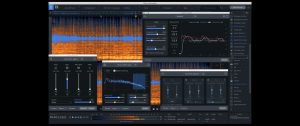Gain staging

On the internet you can�t go anywhere without reading it. Everybody seems to be saying �mind the headroom�, but what is it? Is there a specific set of values you need to mind as a producer? How can you structure your mix to get a consistent signal flow throughout?
What is gain staging
Gain staging is simply put the concept of keeping your signal flow as clean as possible.
Two important terms come to mind:
- Noise floor
- Headroom
In the age of analog recording equipment you had to deal a lot with noise, more than nowadays. All audio equipment, from microphones, to compressors, preamps and tape machines, would produce some form of noise. The trip was to record a signal as loud as possible, to prevent the softer parts from interfering with that noise. If you didn�t mind the noise floor, you would end up with a very noisy recording.While you are busy recording as loud as possible, you would run in to a second issue: headroom. Headroom is the amount of room you have before a signal will clip or distort.
Every recording medium has a finite amount of headroom. The will come a moment when a signal will be too loud for the mic or preamp. See also the article about distortion.
In the analog domain headroom is a gradual concept. Analog preamps and tape machines could be slowly driven into the red. At first a mild compression and saturation would occur that sounds nice. Eventually the saturation would get more intense and into heavy distortion
When gain staging in the analog domain you try to keep every signal in your chain as far above the noise floor without clipping it.
Gain staging in the digital world
Contrary to the old days noise floor is less of a problem nowadays. Most equipment is so silent you barely have to pay attention it. If you record too soft, just crank up the gain in your DAW. You will probably won�t hear any noise.
Modern equipment also has a much bigger headroom, but it still is a very important thing to mind. Where analog headroom is a gradual scale, in the digital domain you have the very abrupt threshold of 0dBFS which you should never exceed. If you do, you will clip directly. But up until that point there is no distortion or coloration whatsoever, so you have much and much more headroom.
At two points in your signal flow you should at least worry about gain staging. Because at these two points your signal will pass analog elements.
First your mic or line signal will need to pas your interface�s AD converter (Analog-to-Digital-converter). Second your final signal needs to leave your interface through your DAW (Digital-to-Analog-converter) to go to your monitors or headphones.
Therefore it�s still important to watch your levels. A good rule of thumb is to keep a threshold of -18dBFS (or 0dBVU). This way the peaks of your signal will can easily be higher without clipping.
Gain staging your plugins
Although the plugins in your DAW are all very much digital, a lot of plugins are emulations of analog gear (such as tape machines, hardware compressors and EQ�s, you name it). A good emulation will display the same amount of distortion as their hardware sibling. The louder the signal, the more discolouration will occur.
Obviously, you can use this to colour your track, but you have to be a bit more conservative with it. In your DAW it�s easy to stack plugin upon plugin upon plugin and you would end up using a lot more than if you were to use only hardware. If you would only slightly distort at each plugin, you would end up with a very distorted signal at the end, and not in the way you want to.
Just like with your ADDA converters, try to keep the signal flow between plugins at -18dBFS. This will optimise your gain structure and prevent unnecessary distortion.
If you up until this point have never bothered to check this, you will notice an immediate improvement in your mixes.
Don�t be afraid to lower a signal. If it makes your mix too soft, just crank up your monitors!
